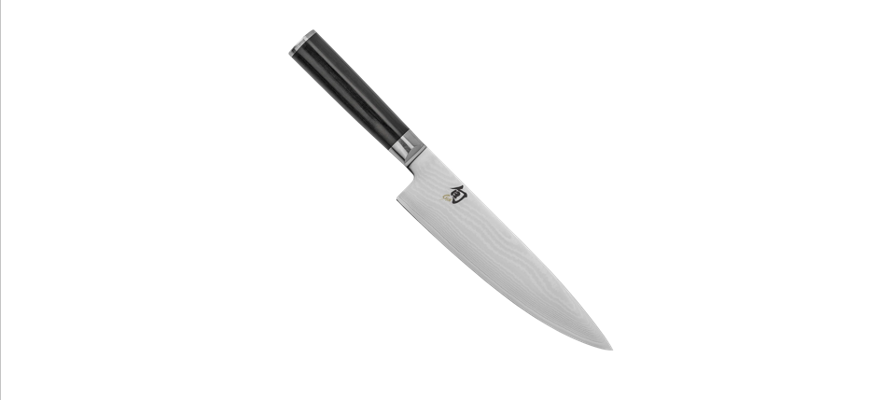on all orders over $150
on all orders over $150

A good set of kitchen knives is essential for any home cook, whether you’re a beginner or a seasoned pro. But with so many different types of knives available, it can be difficult to know which ones to choose for your kitchen. Each knife has its own unique features and uses that make it ideal for certain tasks. In this blog post, we will discuss the different types of kitchen knives and their uses, so you can choose the best knives for your kitchen needs.
The chef’s knife is probably the most versatile knife in the kitchen. With its broad blade that curves upwards to a sharp tip, it’s ideal for chopping, slicing, and dicing fruits, vegetables, herbs, and meats. The curved blade allows for a smooth rocking motion that makes it easy to chop and mince quickly. The blade length ranges from 6 inches for smaller tasks to 12 inches for larger ones, with 8 inches being the most common size.
The Santoku knife is similar in shape and function to the chef’s knife but originated in Japan. It has a shorter, wider blade with a straighter edge that makes it easier to slice through foods without rocking back and forth. It’s great for cutting through boneless meats or preparing vegetables, and the straighter blade makes it perfect for precise cuts like julienne or brunoise. Santoku knives typically range in length from 5 to 8 inches.
The paring knife has a small, narrow blade that is perfect for intricate tasks like peeling, trimming, and slicing small fruits and vegetables. Its short blade and precise tip make it a great choice for all kinds of detail work, such as deveining shrimp, coring fruits, or removing the seeds from a jalapeño pepper. Paring knives typically range in length from 2.5 to 4 inches.
The bread knife has a long, serrated blade that is ideal for slicing through crusty breads without smashing or tearing the delicate interior. It’s also great for cutting through delicate cakes or pastries. The serrated edge provides a gentle sawing motion that allows it to glide through the bread without crushing it. Bread knives typically range in length from 8 to 10 inches.
The utility knife has a narrow, straight blade that is ideal for cutting and slicing larger fruits and vegetables, as well as slicing meats and cheeses. It’s longer than a paring knife but shorter than a chef’s knife, making it a versatile choice for everyday tasks. Utility knives typically range in length from 4 to 7 inches.
The boning knife has a narrow, flexible blade that is ideal for separating meat from bone. It’s also great for filleting fish or trimming poultry. The flexible blade allows you to get close to the bone without damaging the meat. Boning knives typically range in length from 5 to 7 inches.
The cleaver is a large, rectangular knife that is ideal for chopping and slicing through tough meats and bones. It’s also great for crushing garlic or ginger or for scooping up ingredients to transfer from the cutting board to a pan. Cleavers typically range in weight from 1 to 3 pounds and can be used for many tasks beyond meat processing including smashing nuts or slicing fruits.
The serrated knife has a long, narrow blade with serrated edges that are perfect for slicing bread, cakes, and other soft items with a more delicate interior to avoid smashing it. It’s also great for slicing soft vegetables like tomatoes or peppers. Some serrated knives can be large similar to a bread knife or small and can be as short as a paring knife.
The fillet knife is a flexible, narrow blade that is perfect for filleting fish, removing skin from meat and poultry, or simply slicing delicate items like soft fruits or vegetables. The flexibility of the blade allows the user to move it easily through the flesh of the fish or meat, following the bones and curves of the animal.
The Nakiri knife is another Japanese style knife that is meant for chopping vegetables. It looks similar to the Santoku but the blade is straight edge meaning it is better for push cutting vegetables. It is not ideal for slicing meat but gives the user more control when dealing with veggies.
Each type of kitchen knife has its own unique features and uses that make it ideal for certain tasks. By understanding the different types of knives and their uses, you can choose the best knives for your kitchen needs. Remember that the right knife can make all the difference in the kitchen. Investing in a high-quality set of knives and caring for them properly is essential to ensuring they last a long time and provide the best results. So next time you're in the market for kitchen knives, consider all your options and select the ones that fit your cooking needs best. And don’t forget to take good care of your knives with proper cleaning, sharpening, and storage. With these tips in mind, you can make sure your kitchen knives will provide you with years of reliable performance.